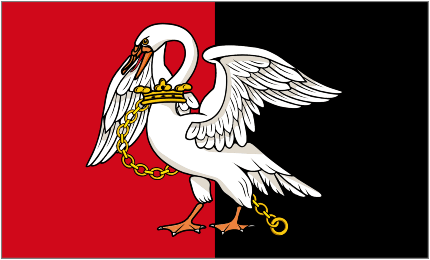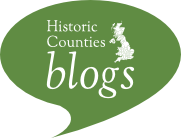The design is a banner of the county council arms which were awarded in 1895. The leopards faces, fondly referred to as loggerheads locally, are a traditional emblem for Shropshire (also known as Salop) and have historically evolved from the lions heads on the Shrewsbury … Continue reading
» Blog
Nottinghamshire
The flag of Nottinghamshire was the winning entry in a 2011 competition initiated by the local BBC Radio station under the auspices of the Flag Institute. The flag incorporates St George’s cross fimbriated in white, on a dark green background, with at its centre a … Continue reading
Dorset
After a hard struggle, popular opinion finally convinced the local council in Dorset to organise a flag competition. The winning design conceived by Stephen Coombes and Dave White,had been promoted for some time before the council, having been initially opposed to the idea of a … Continue reading
Northumberland
Although not registered as a “traditional” design, Northumberland’s flag is of ancient origin and in essence is certainly part of a local tradition, of some ancient standing. The Venerable Bede, England’s first historian, records a banner of purple and gold which hung over the tomb of St Oswald, … Continue reading
Caernarfonshire
Three gold eagles in fess ( arranged horizontally) on a green field, is a banner of the arms attributed to Owain King of Gwynedd whose kingdom covered most of the present day county. This same pattern of three gold eagles on a green field was mentioned by … Continue reading

Buckinghamshire
A white swan on a bicolour field of red and black is a traditional emblem of Buckinghamshire. The Swan emblem dates back to Anglo-Saxon times when Buckinghamshire was known for breeding swans for the king. The same pattern is also used on its arms by … Continue reading
Middlesex
The same seaxes as used in Essex were also used in Middlesex which originally formed part of the early Essex kingdom. In 1910 the addition of a Saxon crown, from the College of Arms, gave a distinct set of arms to Middlesex County Council. With the demise of … Continue reading
Sussex
The six gold martlets (heraldic swallows) on a blue field have been associated with the county of Sussex for centuries. They featured in John Speed’s 1611 atlas on a map the depicting the Anglo-Saxon kingdoms, attesting to its venerable status. The emblem is used by a … Continue reading
Kent
Along with emblems for Essex and Sussex, the Kent horse was were notably featured in the celebrated county atlas produced by John Speed in 1611 on a map depicting the Anglo-Saxon kingdoms. Long believed to have been based on a local tradition, referencing local tales … Continue reading
Cornwall
Possibly the oldest of the county flags is that of Cornwall (although many Cornishmen of course would assert that it is in fact a national flag!). This plain white cross on a black field, named the Cross of Saint Piran, has been used since at … Continue reading
